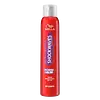What's inside
What's inside
 Key Ingredients
Key Ingredients

 Benefits
Benefits

No benefits
 Concerns
Concerns

 Ingredients Side-by-side
Ingredients Side-by-side

Water
Skin ConditioningSodium Laureth Sulfate
CleansingSodium Lauryl Sulfate
CleansingGlycol Distearate
EmollientDimethicone
EmollientCocamidopropyl Betaine
CleansingSodium Citrate
BufferingCocamide Mea
EmulsifyingSodium Xylenesulfonate
Parfum
MaskingSodium Benzoate
MaskingSodium Chloride
MaskingCitric Acid
BufferingSalicylic Acid
MaskingGlycerin
HumectantTetrasodium EDTA
Guar Hydroxypropyltrimonium Chloride
Skin ConditioningMenthol
MaskingMethylparaben
PreservativeLimonene
PerfumingPropylene Glycol
HumectantBenzyl Alcohol
PerfumingHydrochloric Acid
BufferingVitis Vinifera Fruit Extract
Skin ConditioningMagnesium Nitrate
Methylchloroisothiazolinone
PreservativePotassium Benzoate
PreservativeMagnesium Chloride
Methylisothiazolinone
PreservativeWater, Sodium Laureth Sulfate, Sodium Lauryl Sulfate, Glycol Distearate, Dimethicone, Cocamidopropyl Betaine, Sodium Citrate, Cocamide Mea, Sodium Xylenesulfonate, Parfum, Sodium Benzoate, Sodium Chloride, Citric Acid, Salicylic Acid, Glycerin, Tetrasodium EDTA, Guar Hydroxypropyltrimonium Chloride, Menthol, Methylparaben, Limonene, Propylene Glycol, Benzyl Alcohol, Hydrochloric Acid, Vitis Vinifera Fruit Extract, Magnesium Nitrate, Methylchloroisothiazolinone, Potassium Benzoate, Magnesium Chloride, Methylisothiazolinone
Ingredients Explained
These ingredients are found in both products.
Ingredients higher up in an ingredient list are typically present in a larger amount.
Parfum is a catch-all term for an ingredient or more that is used to give a scent to products.
Also called "fragrance", this ingredient can be a blend of hundreds of chemicals or plant oils. This means every product with "fragrance" or "parfum" in the ingredients list is a different mixture.
For instance, Habanolide is a proprietary trade name for a specific aroma chemical. When used as a fragrance ingredient in cosmetics, most aroma chemicals fall under the broad labeling category of “FRAGRANCE” or “PARFUM” according to EU and US regulations.
The term 'parfum' or 'fragrance' is not regulated in many countries. In many cases, it is up to the brand to define this term.
For instance, many brands choose to label themselves as "fragrance-free" because they are not using synthetic fragrances. However, their products may still contain ingredients such as essential oils that are considered a fragrance by INCI standards.
One example is Calendula flower extract. Calendula is an essential oil that still imparts a scent or 'fragrance'.
Depending on the blend, the ingredients in the mixture can cause allergies and sensitivities on the skin. Some ingredients that are known EU allergens include linalool and citronellol.
Parfum can also be used to mask or cover an unpleasant scent.
The bottom line is: not all fragrances/parfum/ingredients are created equally. If you are worried about fragrances, we recommend taking a closer look at an ingredient. And of course, we always recommend speaking with a professional.
Learn more about ParfumWater. It's the most common cosmetic ingredient of all. You'll usually see it at the top of ingredient lists, meaning that it makes up the largest part of the product.
So why is it so popular? Water most often acts as a solvent - this means that it helps dissolve other ingredients into the formulation.
You'll also recognize water as that liquid we all need to stay alive. If you see this, drink a glass of water. Stay hydrated!
Learn more about Water